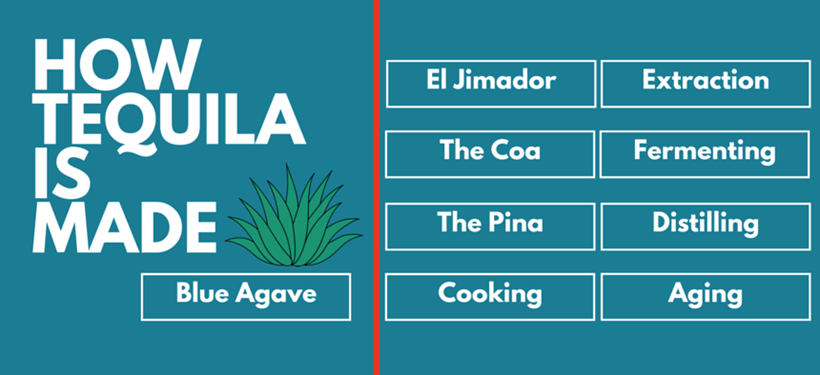
Ever wondered how Tequila is made? Well, you are about to find out. Take a look at this infographic and it will walk you through the entire process from the field to your glass. Now let’s pretend that every day is Cinco de Mayo and raise a glass of this wonderful product of Mexico.
Tequila Origins
Tequila can only be made in 180 municipalities in five different states covering 27 million acres in Mexico. The largest majority is produced in the highlands of Mexico’s Jalisco state. The production of tequila can only be found here because it is the place of origin. This is designed to protect it both geographically and agriculturally. Ironically, the U.S. leads the way in tequila consumption, nearly doubling its home country of Mexico.
The Blue Agave
The blue agave plant is the heart of tequila. The juices of this plant are distilled to make the widely loved beverage. The Blue Agave thrives in full exposure to the sun, but is extremely sensitive to temperatures below freezing. This prickly plant can grow up to 5 ft. tall by 5 ft. wide. and live anywhere from 8-14 years. Although commonly mistaken for a cactus, it is actually a member of the lily family.
Stay Informed: Sign up here for our Distillery Trail free email newsletter and be the first to get all the latest news, trends, job listings and events in your inbox.
El Jimador
A Jimador is a farmer that is oversees the blue agave plant’s growth during its 8-14 year lifespan. Jimadors are expert artisans as they oversee a year round process of harvesting and replanting Blue Agave. The Jimadors are thought to harvest an average of nearly 300 million Blue Agave plants each year. On a good day a Jimador can harvest nearly 5 tons of Agave.
The Coa
The coa is the Jimador’s weapon of choice in harvesting the Blue Agave plant. It is made up of a sharpened semi-circular blade attached to elongated wooden handle. The coa is reminiscent of the the harvesting hoe and the machete. The tool is highly effective in uprooting the agave and cutting through it’s 200 plus thorny leaves.
The Pina
A harvested Blue Agave plant is called a “pina” due to it’s resemblance to a pineapple. The pina has been known to weigh in from 50 to 200 pounds. It can take up to 17 pounds of pina to produce 1 liter of tequila.
The Pina Heart
The Pina is harvested for it’s heart which is found within it’s core. The key to a quality pina heart is based upon harvesting it once it has matured to it’s highest sugar content. This usually occurs at the older stages of life of the Blue Agave Plant towards the end of the growing season. Upon extracting the pina’ heart is split into halves and sent to the next part of the process.
Cooking
The next step in the tequila process is the cooking of the pina heart. Traditionally, the pina is cooked in a brick oven and is softened by strategically injected steam over a 2-3 day period. This steam injection triggers a chemical reaction that allows the carbohydrates found with in the pina heart to be transformed into a fermentable sugar.
Extraction
At this point, the pina has transformed from a white color to a deep brownish red. Extraction begins by shredding and then crushing the baked pina heart. The crushing task is traditionally undertook with a massive wheel shaped stone which allows the sugars to be further separated fromthe pina’s fibers. After being throughly strained, the sugar juice must enter the fermentation process.
Fermenting
The agave juice is then fermented within the bounds of a stainless steel tank or wooden vat. When the temperature of the agave juice increases, the sugars are converted into alcohol. Traditionally. the yeast found organically on the agave’s leaves are used to speed up the fermentation process. Depending on the fermentation process, this step can take anywhere from 1-2 weeks.
Distilling
The distillation process allows the fermented juice to be purified. This occurs in a still or a tower. The distilling cycles normally occur 2-3 times. A quality distillation will most notably capture the aroma of the Blue Agave.
Aging
Mexican law dictates that all tequila must be aged at least 14-21 days. This traditionally occurs in wooden holding tanks and casks. The length of the aging process determines the type oftequila. The aging process also allows the tequila to take on different colors, flavor profiles, and a variety of levels of drinkability. The age of the tequila will typically determine price.
Tequila Types
The required 14-21 days aging process produces a blanco or white tequila. Tequila aged 2 months or longer is classified as a gold tequila. If it is aged beyond 2 months to 364 days, it is called a respado or rested tequila. The most expensive tequila is aged 1 year and beyond. This is called an anejo or old tequila which means old.
Bottling
By law, all bottling of tequila must occur in Mexico due to its denomination of origin status. An authentic bottle tequila will state “Hecho en Mexico” or “Made in Mexico”. Before bottling, it is usually filtered a final time to allow any solids to be removed from the tequila. The bottles are also thoughtfully crafted and are commonly collected as art work.
This infographic on “How Tequilla is Made” is compliments of Mixer Direct.















